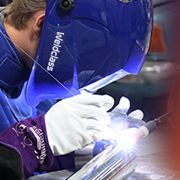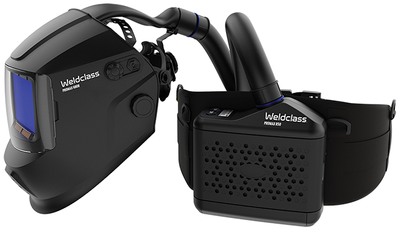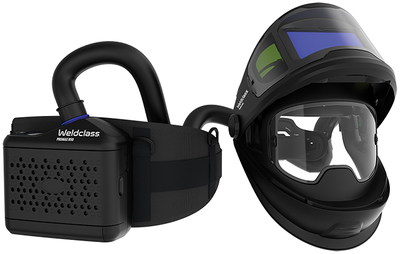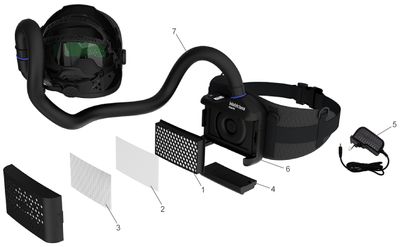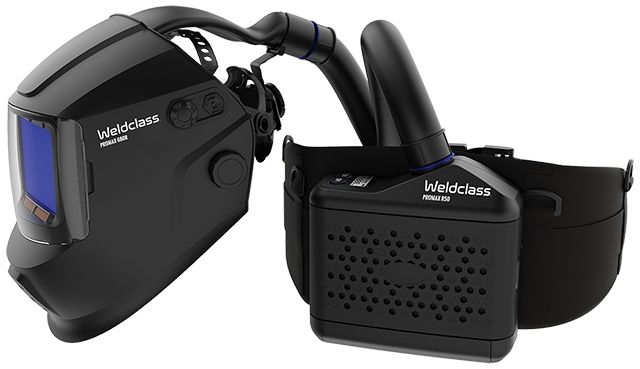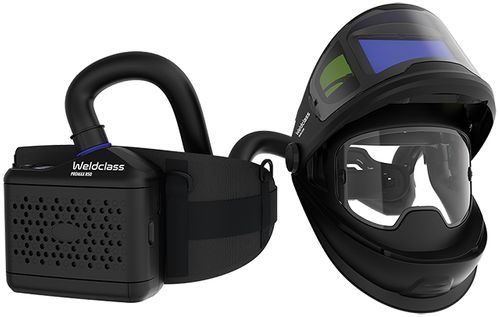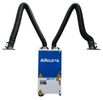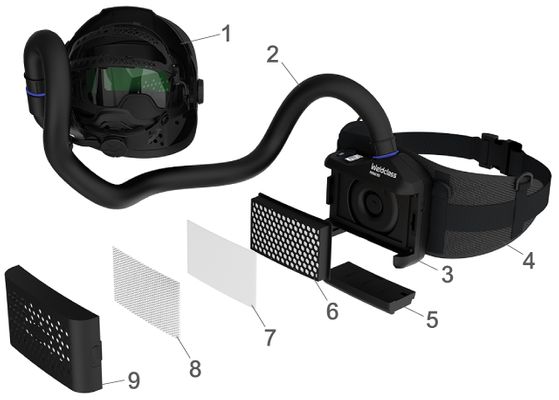Respirator Welding Helmet | Welding Mask With Respirator
The complete guide to the Respirator Welding Helmet, or PAPR Welding Helmet, plus comparisons with other welding fume control and safety methods.
In this guide we cover: Weldclass PAPR range | What to look for in a PAPR helmet | Welding helmet with respirator vs other fume protection methods | What is PAPR | PAPR Components and functions | PAPR Maintenance | Video review of Weldclass air fed helmets.
Explore The Range Of PAPR Welding Helmets by Weldclass
Click through to each product for more product details, RRP prices, and info on where to buy.
-
Breathe easy and weld with confidence! The PROMAX 680R powered air respirator welding helmet offers amazing value with the comfort and reliability that Weldclass helmets have delivered for decades. Enjoy the benefits of purified air supplied by the powerful PROMAX R50 battery-powered respirator, keeping you cool and protected from harmful welding fumes. Helmet features include; Advanced digital lens with industry-leading leading 7-year warranty offer, Enormous 95cm2 'landscape' view with ultra-crisp V1rated optics, LCD illuminated self-dimming controls, External adjustments, and much more. Elevate your welding game today with the PROMAX 680R welding helmet with respirator!
PAPR Welding Helmet Guide -
Breathe easy and weld with confidence! The PROMAX 850R powered air respirator welding helmet delivers exceptional value, with the comfort and reliability Weldclass helmets have delivered for decades. Flip-up design features a large clear grinding visor, for seamless transition between welding and grinding, plus shade 5 side windows for wide peripheral vision when welding. The next-generation digital lens offers advanced adjustments and features, super crisp V1-rated optics, and super-size 95cm2 view area, backed by our industry-leading 7-year warranty offer. Stay cool and protected with purified air from the powerful PROMAX R50 battery-powered respirator, shielding you from harmful fumes, with bonus second battery for uninterrupted performance during longer shifts. Upgrade your welding experience today with the PROMAX 850R welding helmet with respirator!
PAPR Welding Helmet Guide -
Replacement filters and other spare parts to suit Promax R50 PAPR Respirator, as used with Promax 680R and Promax 850R respirator welding helmets.
What to look for in a Welding Helmet With Respirator
Here's some key features and differences to be aware of, when shopping for Welding helmets with PAPR respirator / air fed systems:
1. Standard vs Flip-Up
Because air fed welding masks need to incorporate air ducts, face seals, etc, they are more cumbersome to fit and remove vs a standard welding helmet. This can be an inconvenience where the operator would traditionally lift up, or remove, the helmet to adjust the auto-darkening lens controls, or for better vision when grinding, etc. To address this, some PAPR welding helmet models now offer external controls, and/or a flip-up welding lens. Here's a comparison between different helmet designs:
|
PAPR Helmet Design |
Pros ✅ |
Cons ❌ |
|
Standard with Internal Controls |
|
|
|
Standard with External Controls / Grind Mode Example: Weldclass Promax 680R |
|
|
|
Flip-Up with large grinding visor Example: Weldclass Promax 850R |
|
|
2. Cost Of Consumables
This factor is often overlooked during the initial purchase decision. Over the lifetime of a welding helmet with respirator, the accumulated cost of replacement filters can easily exceed the original cost of the helmet. Replacement filters for the Weldclass PROMAX R50 PAPR respirator unit are priced very competitively (up to 50% lower than some other brands), to reduce operating costs and maximise ROI on your helmet investment.
3. Filter Size vs Battery Size
The size of the replaceable filter (eg surface area of the filter in cm2) can have an impact on the performance, and ongoing maintenance cost, of the respirator unit. A larger filter will typically absorb more fume dust and therefore last longer before needing to be replaced, however this places more demand on the battery and shortens battery charge life. Conversely, a smaller filter will need to be replaced more frequently, but will reduce battery load.
The Weldclass PROMAX R50 PAPR respirator unit (supplied with PROMAX 680R and PROMAX 850R PAPR helmets) features a high quality battery to provide an operating time of up to 10 hours, whilst also allowing generous filter size to be used to maximise filter life and lower maintenance cost.
4. Compliance to Australian Standards
Not all welding helmet respirator systems are tested to, or compliant with, Australian standards. The applicable standards include AS/NZS 1716 (respirator), AS/NZS 1337.1 (welding helmet), and AS/NZS 1338.1 (auto-darkening lens).
Weldclass PROMAX 680R and PROMAX 850R PAPR helmets comply with these standards, giving you peace of mind that your investment will provide the protection that you need and expect.
5. Weight and Ergonomics
A welding helmets with respirator system includes a lot more components than a standard helmet, so it's no suprise that they are higher in weight and more cumbersome. That said, some PAPR welding helmets are better than others when it comes to weight and ergonomics. Weldclass PAPR helmets incorporate thousand of hours of design, testing, re-design, and live trials with Aussie welders to achieve the best possible combination of; minimal weight, weight balance and comfort - without compromising safety and durability. A common response from first-time users of Weldclass PAPR helmets is "wow, that feels so much lighter than the other brand we have been using".
6. Viewing Area
While standard helmets are very easy to flip-up and/or remove, this is not quite the case with PAPR units which have additional componentry including face seals, air ducts, and hoses. Also to protect the user, a PAPR helmet should not be removed while the user is in a fume-contaminated area. This means that the helmet is likely to remain worn for longer periods, and helmets with a larger viewing area are a definite advantage.
Both the Weldclass Promax 680R and 850R PAPR helmets boast a super-size 95mm2 viewing area that is up to 55% larger than other well-known PAPR helmets on the market. In addition, the Promax 850R offers a flip-up lens with large clear grinding visor and shade 5 side windows for extended peripheral vision when welding.
Welding Mask With Respirator vs Other Fume Control Methods
Here we cover some of the key pros and cons of welding helmets with respirators (or PAPR welding helmets), vs other methods of welding fume control.
|
Fume Control System |
Pros ✅ |
Cons ❌ |
|
Welding Helmet with PAPR Respirator |
|
|
|
Fume Extraction MIG or TIG Welding Torch |
|
|
|
Mobile Welding Fume Extractor |
|
|
|
Ducted / Central Fume Extraction System |
|
|
What is PAPR Welding Helmet?
A PAPR (Powered Air Purifying Respirator) welding helmet is an advanced protective device designed for welders, combining respiratory protection with eye and face shielding. This type of helmet incorporates a battery-powered 'blower' that pulls air through a filter, removing contaminants such as dust, fumes, and particles before delivering clean air into the helmet's breathing zone. The continuous flow of positive-pressure purified air not only helps in preventing inhalation of harmful substances but also keeps the welder cool and comfortable. PAPR welding helmets are particularly beneficial in environments with high levels of airborne pollutants, ensuring enhanced safety and compliance with health regulations while allowing welders to perform their tasks with improved visibility and reduced fatigue.
Air Fed Welding Helmet Parts and Components
All PAPR welding helmets typically include the following components:
- Welding helmet: Fitted with face seal to keep contaminated air out of the users breathing zone.
- Breathing tube or hose: Transports purified air from the respirator to the welding helmet.
- Respirator blower unit: Incudes motor and fan, and houses filter components.
- Waist Belt: On some models this may include shoulder harness to improve operator comfort.
- Battery: Powers the blower unit.
- Main particle filter: Filters harmful particles, such as welding fume dust, from contaminated air.
- Pre-Filter: Filters out larger particles before contaminated air reaches the main filter, to reduce clogging and maximise filter life. Some prefilter are available with activated carbon to eliminate odours for improved operator comfort.
- Spark arrestor: Thin metal mesh that prevents sparks from entering filter components, which would otherwise present risk of fire or damage.
- Filter cover: Holds all filter components in place.
Maintenance of Respirator Welding Helmets
PAPR welding helmets are typically easy to use and maintain, however it is important to follow a regular maintenance schedule so that the respirator and helmet continue to function correctly and protect the operator. This article outlines recommended maintenance proceedures for Weldclass PAPR welding helmets.
Video Reviews: Weldclass PAPR Welding Helmets
Join Tim Thompson at Trigger Engineering (aka Fencestay), Heidelberg West Victoria as he trials and reviews the Weldclass PROMAX 850R welding helmet with respirator:
Home Built By Jeff trials tests the PROMAX 850R on his "Frankenhauler" truck build project:


